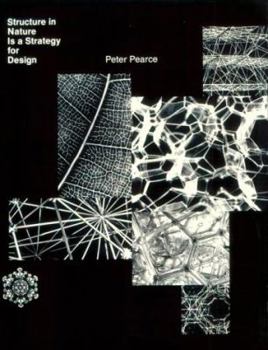Structure in Nature Is a Strategy for Design
Select Format
Select Condition 
Book Overview
The structural designs that occur in nature-in molecules, in crystals, in living cells, in galaxies-are the proper source of inspiration. Peter Pearce affirms, for the design of man-made structures. Nature at all levels builds responsive and adaptive structures that conserve material and energy resources through the use of modular components combined with least-energy structural strategies. This book-itself designed with graphic modularity and richly illustrated with examples of forms created by nature and by man, including some remarkable and surprising architectural structures developed by the author-leads the designer in this "natural" direction, beyond the familiar limitations of the right angle and the cube and into a richer world of forms based on the triangle, the hexagon, and general polyhedral, as well as saddle polyhedral spanned by minimal continuous surfaces. The author writes that "Systems can be envisaged which consist of some minimum inventory of component types which can be alternatively combined to yield a great diversity of efficient structural form. We call these minimum inventory/maximum diversity systems. "By such a 'system' I mean a minimized inventory of component types (a kit of parts) along with rubrics whereby the components may be combined.... The snowflake is the most graphic example in nature of the minimum inventory/maximum diversity principle. In fact, it may be considered an archetype of physicogeometric expression. All planar snow crystals are found to have star-like forms with six corners (or subsets thereof).... However, within this six-fold form, no two snowflakes have ever been known to be exactly alike.... "An integral part of the concept of minimum inventory/maximum diversity systems is the principle of conservation of resources. The formative processes in natural structure are characteristically governed by least-energy responses. Perhaps the simplest expression of this is found in the principle of closest packing, a principle which even in its most elementary form is common in both the animate and inanimate worlds." Pearce's work follows in the tradition established by D'Arcy Wentworth Thompson and Konrad Wachsmann, and reflects his earlier close working association with Charles Eames and Buckminster Fuller. Many of the ideas explored in this book have already undergone "reduction to practice" in the firm Pearce founded, Synestructics, Inc. Its initial products have been kits and kites and a ministructure large enough for kids to crawl through, the "Curved Space Labyrinth," a saddle polyhedral system made of transparent plastic. Adult-sized structures, and indeed megastructures, based on these principles can be realized as soon as entrepreneurs emerge whose vision is commensurate with that of Peter Pearce.
Format:Hardcover
Language:English
ISBN:0262160641
ISBN13:9780262160643
Release Date:January 1978
Publisher:MIT Press (MA)
Length:245 Pages
Weight:2.10 lbs.
Customer Reviews
0 rating





